#uttariya
Text
Origins of the Pibo: Let’s take a trip along the Silk Road.
1. Introduction to the garment:
Pibo 披帛 refers to a very thin and long shawl worn by women in ancient East Asia approximately between the 5th to 13th centuries CE. Pibo is a modern name and its historical counterpart was pei 帔. But I’ll use pibo as to not confuse it with Ming dynasty’s xiapei 霞帔 and a much shorter shawl worn in ancient times also called pei.
Below is a ceramic representation of the popular pibo.
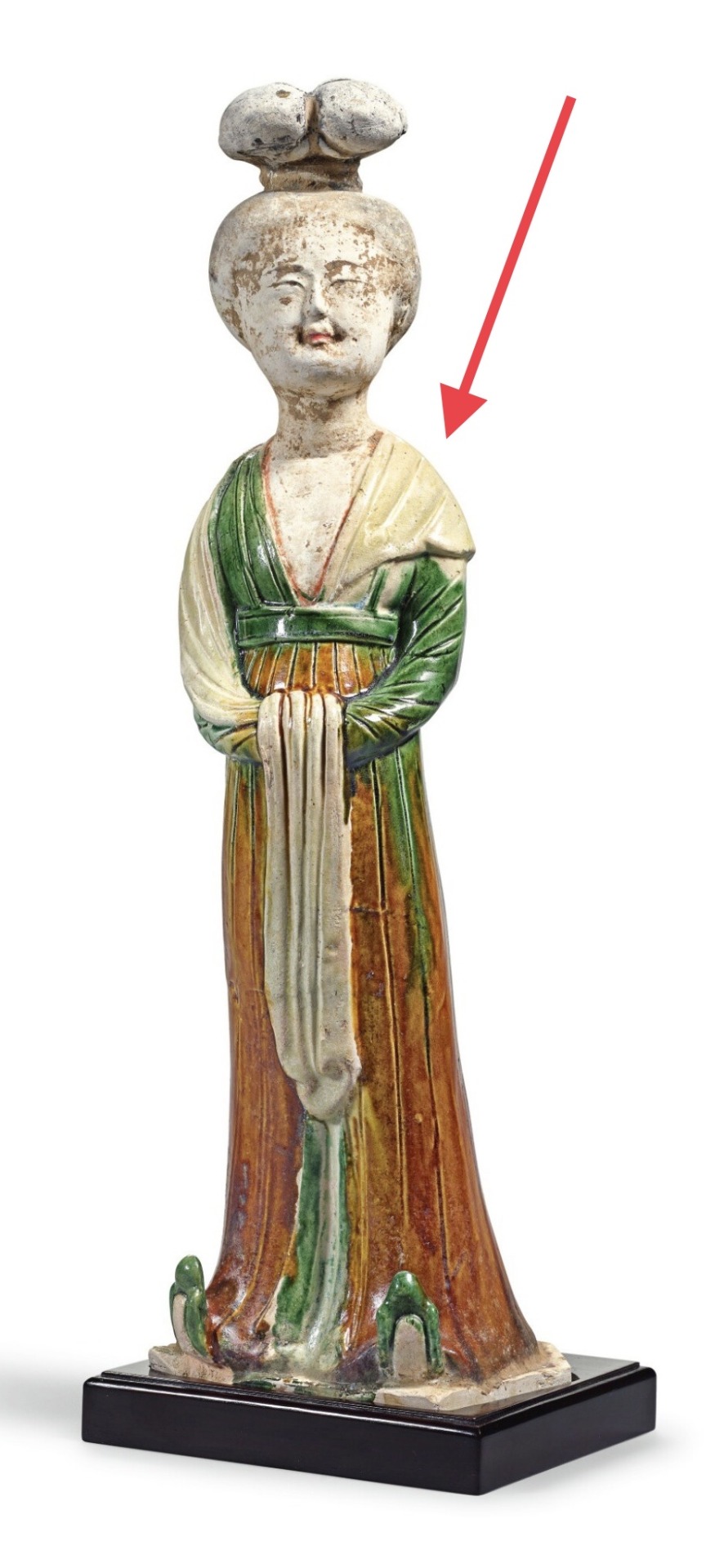
A sancai-glazed figure of a court lady, Tang Dynasty (618–690, 705–907 CE) from the Sze Yuan Tang Collection. Artist unknown. Sotheby’s [image source].
Although some internet sources claim that pibo in China can be traced as far back as the Qin (221-206 BCE) or Han (202 BCE–9 CE; 25–220 CE) dynasties, we don’t start seeing it be depicted as we know it today until the Northern and Southern dynasties period (420-589 CE). This has led to scholars placing pibo’s introduction to East Asia until after Buddhism was introduced in China. Despite the earliest art representations of the long scarf-like shawl coming from the Northern and Southern Dynasties period, the pibo reached its popularity apex in the Tang Dynasty (618–690 CE: 705–907 CE).
Academic consensus: Introduction via the Silk Road.
The definitive academic consensus is that pibo evolved from the dajin 搭巾 (a long and thin scarf) worn by Buddhist icons introduced to China via the Silk Road from West Asia.
披帛是通过丝绸之路传入中国的西亚文化, 与中国服饰发展的内因相结合而流行开来的一种"时世妆" 的形式. 沿丝绸之路所发现的披帛, 反映了丝绸贸易的活跃.
[Trans] Pibo (a long piece of cloth covering the back of the shoulders) was a popular female fashion period accessory introduced to China by West Asian cultures by way of the Silk Road and the development of Chinese costumes. The brocade scarves found along the Silk Road reflect the prosperity of the silk trade that flourished in China's past (Lu & Xu, 2015).
I want to add to the above theory my own speculation that, what the Chinese considered to be dajin, was most likely an ancient Indian garment called uttariya उत्तरीय.
2. Personal conjecture: Uttariya as a tentative origin to pibo.
In India, since Vedic times (1500-500 BCE), we see mentions in records describing women and men wearing a thin scarf-like garment called “uttariya”. It is a precursor of the now famous sari. Although the most famous depiction of uttariya is when it is wrapped around the left arm in a loop, we do have other representations where it is draped over the shoulders and cubital area (reverse of the elbow).
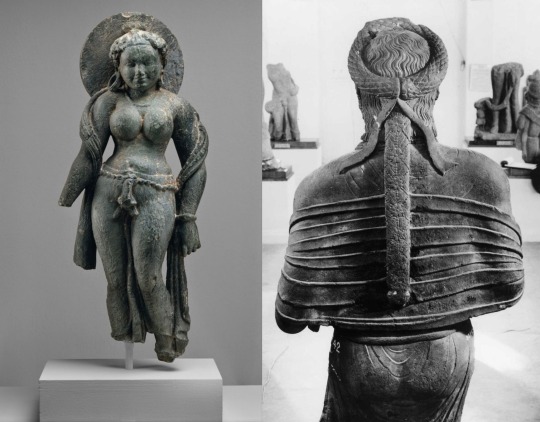
Left: Hindu sculpture “Mother Goddess (Matrika)”, mid 6th century CE, gray schist. Artist unknown. Looted from Rajasthan (Tanesara), India. Photo credit to Metropolitan Museum of Art, New York, United States [image source].
Right: Rear view of female statue possibly representing Kambojika, the Chief Queen of Mahakshatrapa Rajula, ca. 1st century CE. Artist unknown. Found in the Saptarishi Mound, Mathura, India. Government Museum, Mathura [image source].
Buddhism takes many elements from Hindu mythology, including apsaras अप्सरा (water nymphs) and gandharvas गन्धर्व (celestial musicians). The former was translated as feitian 飞天 in China. Hindu deities were depicted wearing clothes similar to what Indian people wore, among which we find uttariya, often portrayed in carvings and sculptures of flying and dancing apsaras or gods to show dynamic movement. Nevertheless, uttariya long predated Buddhism and Hinduism.
Below are carved representation of Indian apsaras and gandharvas. Notice how the uttariya are used.

Upper left: Carved relief of flying celestials (Apsara and Gandharva) in the Chalukyan style, 7th century CE, Chalukyan Dynasty (543-753 CE). Artist Unknown. Aihole, Karnataka, India. National Museum, New Delhi, India [image source]. The Chalukyan art style was very influential in early Chinese Buddhist art.
Upper right: Carved relief of flying celestials (gandharvas) from the 10th to the 12th centuries CE. Artist unknown. Karnataka, India. National Museum, New Delhi, India [image source].
Bottom: A Viyadhara (wisdom-holder; demi-god) couple, ca. 525 CE. Artist unknown. Photo taken by Nomu420 on May 10, 2014. Sondani, Mandsaur, India [image source].
Below are some of the earliest representations of flying apsaras found in the Mogao Caves, Gansu Province, China. An important pilgrimage site along the Silk Road where East and West met.
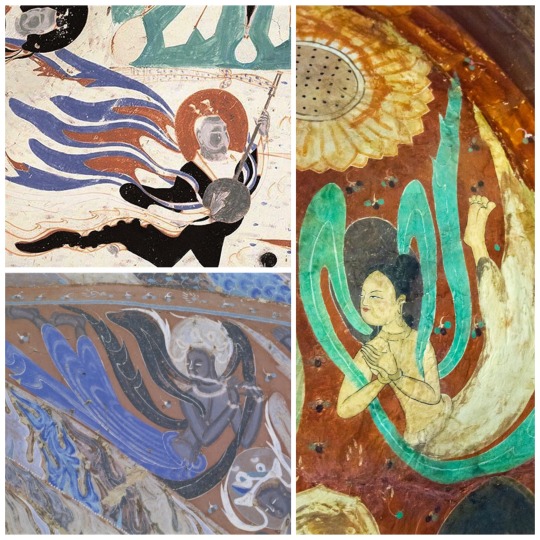
Left to right: Cave No. 461, detail of mural in the roof of the cave depicting either a flying apsara or a celestial musician. Western Wei dynasty (535–556 CE). Artist unknown. Mogao Grottoes, Dunhuang, China [image source].
Cave 285 flying apsara (feitian) in one of the Mogao Caves. Western Wei Dynasty (535–556 CE), Artist unknown. Photo taken by Keren Su for Getty Images. Mogao Grottoes, Dunhuang, China [image source].
Cave 249. Mural painting of feitian playing a flute, Western Wei Dynasty (535-556 CE). Image courtesy by Wang Kefen from The Complete Collection of Dunhuang Grottoes, Vol. 17, Paintings of Dance, The Commercial Press, Hong Kong, 2001, p. 15. Mogao Grottoes, Dunhuang, China [image source].
I theorize that it is likely that the pibo was introduced to China via Buddhism and Buddhist iconography that depicted apsaras (feitian) and other deites wearing uttariya and translated it to dajin.
3. Trickle down fashion: Buddhism’s journey to the East.
However, since Buddhism and its Indian-based fashion spread to West Asia first, to Sassanian Persians and Sogdians, it is likely that, by the time it reached the Han Chinese in the first century CE, it came with Persian and Sogdian influence. Persians’ fashion during the Sassanian Empire (224–651 CE) was influenced by Greeks (hellenization) who also had a a thin long scarf-like garment called an epliblema ἐπίβλημα, often depicted in amphora (vases) of Greek theater scenes and sculptures of deities.

Left to right: Dame Baillehache from Attica, Greece. 3rd century BCE, Hellenistic period (323-30 BCE), terracotta statuette. Photo taken by Hervé Lewandowski. Louvre Museum, Paris, France [image source].
Deatail view of amphora depicting the goddess Artemis by Athenian vase painter, Andokides, ca. 525 BCE, terracotta. Found in Vulci, Italy. Altes Museum, Berlin, Germany [image source].
Statue of a Kore (young girl), ca. 570 BCE, Archaic Period (700-480 BCE), marble. Artist unknown. Uncovered from Attica, Greece. Acropolis Museum, Athens, Greece [image source].
Detail view of Panathenaic (Olympic Games) prize amphora with lid, 363–362 BCE, Attributed to the Painter of the Wedding Procession and signed by Nikodemos, terracotta. Uncovered from Athens, Greece. J. Paul Getty Museum, Los Angeles, California, United States [image source].
Roman statue depicting Euterpe, muse of lyric poetry and music, ca. 2nd century CE, marble, Artist unknown. From the Villa of G. Cassius Longinus near Tivoli, Italy. Photo taken by Egisto Sani on March 12, 2012, Vatican Museums, Rome, Italy [image source].
Greek (or Italic) tomb mural painting from the Tomb of the Diver, ca. 470 BCE, fresco. Artist unknown. Photo taken by Floriano Rescigno. Necropolis of Paestum, Italy [image source].
Below are Iranian and Iraqi period representations of this long thin scarf.

Left to right: Closeup of ewer likely depicting a female dancer from the Sasanian Period (224–651 CE) in ancient Persia , Iran, 6th-7th century CE, silver and gilt. Artist unknown. Mary Harrsch. July 10, 2015. Arthur M. Sackler Gallery of Asian Art, Smithsonian, Washington D.C [image source].
Ewer with nude dancer probably representing a maenad, companion of Dionysus from the Sasanian Period (224–651 CE) in ancient Persia, Iran, 6th-7th century CE, silver and gilt. Artist unknown. Mary Harrsch. July 16, 2015. Arthur M. Sackler Gallery of Asian Art, Smithsonian, Washington D.C [image source].
Painting reconstructing the image of unveiled female dancers depicted in a fresco, Early Abbasid period (750-1258 CE), about 836-839 CE from Jawsaq al-Khaqani, Samarra, Iraq. Museum of Turkish and Islamic Art, Istanbul [image source].
The earliest depictions of Buddha in China, were very similar to West Asian depictions. Ever wonder why Buddha wears a long draped robe similar to a Greek himation (Romans called it toga)?
Take a look below at how much the Greeks influenced the Kushans in their art and fashion. The top left image is one of the earliest depictions of Buddha in China. Note the similarities between it and the Gandhara Buddha on the right.
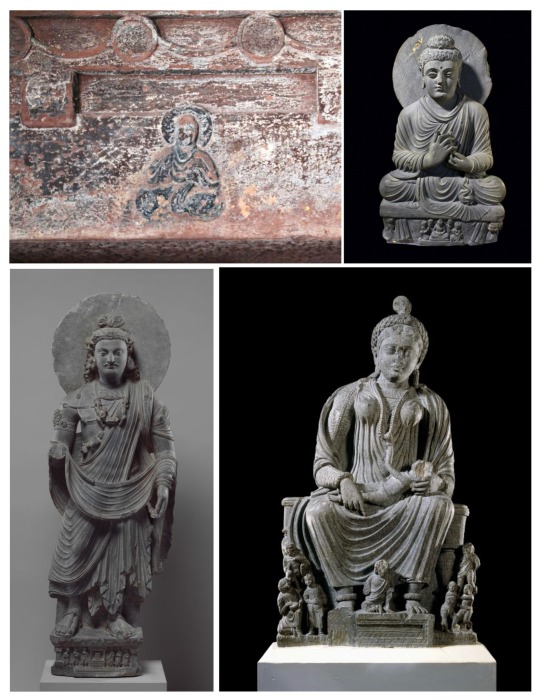
Left: Seated Buddha, Mahao Cliff Tomb, Sichuan Province, Eastern Han Dynasty, late 2nd century C.E. (photo: Gary Todd, CC0).
Right: Seated Buddha from Gandhara, Pakistan c. 2nd–3rd century C.E., Gandhara, schist (© Trustees of the British Museum)
Standing Bodhisattva Maitreya (Buddha of the Future), ca. 3rd century, gray schist. From Gandhara, Pakistan. Image credit to The Metropolitan Museum of Art, New York City, United States [image source].
Statue of seated goddess Hariti with children, ca. 2nd to 3rd centuries CE, schist. Artist unknown. From Gandhara, Pakistan. The British Museum, London, England [image source].
Before Buddhism spread outside of Northern India (birthplace), Indians never portrayed Buddha in human form.
Early Buddhist art is aniconic, meaning the Buddha is not represented in human form. Instead, Buddha is represented using symbols, such as the Bodhi tree (where he attained enlightenment), a wheel (symbolic of Dharma or the Wheel of Law), and a parasol (symbolic of the Buddha’s royal background), just to name a few. […] One of the earliest images [of Buddha in China] is a carving of a seated Buddha wearing a Gandharan-style robe discovered in a tomb dated to the late 2nd century C.E. (Eastern Han) in Sichuan province. Ancient Gandhara (located in present-day Afghanistan, Pakistan, and northwest India) was a major center for the production of Buddhist sculpture under Kushan patronage. The Kushans occupied portions of present-day Afghanistan, Pakistan, and North India from the 1st through the 3rd centuries and were the first to depict the Buddha in human form. Gandharan sculpture combined local Greco-Roman styles with Indian and steppe influences (Chaffin, 2022).
In the Mogao Caves, which contain some of the earliest Buddhist mural paintings in China, we see how initial Chinese Buddhist art depicted Indian fashion as opposed to the later hanfu-inspired garments.

Left to right: Cave 285, detail of wall painting, Western Wei dynasty (535–556 CE). Mogao Grottoes, Dunhuang, China. Courtesy the Dunhuang Academy [image source]. Note the clothes the man is wearing. It looks very similar to a lungi (a long men’s skirt).
Photo of Indian man sitting next to closed store wearing shirt, scarf, lungi and slippers. Paul Prescott. February 20, 2015. Varanasi, India [image source].
Cave 285, mural depiction of worshipping bodhisattvas, 6th century CE, Wei Dynasty (535-556 A.D.), Unknown artist. Mogao Grottoes, Dunhuang, China. Notice the half bow on his hips. That is a common style of tying patka (also known as pataka; cloth sashes) that we see throughout Indian history. Many of early Chinese Buddhist paintings feature it, including the ones at Mogao Caves.
Indian relief of Ashoka wearing dhoti and patka, ca. 1st century BC, Unknown artist. From the Amaravathi village, Guntur district, Andhra Pradesh, India. Currently at the Guimet Museum, Paris [image source].
Cave 263. Mural showing underlying painting, Northern Wei Dynasty (386–535 CE). Artist Unknown. Picture taken November 29, 2011, Mogao Grottoes, Dunhuang, China [image source]. Note the pants that look to be dhoti.
Comparison photo of modern dhoti advertisement from Etsy [image source].
Spread of Buddhism to East Asia.

Map depicting the spread of Buddhism from Northern India to the rest of Asia. Gunawan Kartapranata. January 31, 2014 [image source]. Note how Mahayana Buddhism arrived to China after passing through Kushan, Bactrean, and nomadic steppe lands, absorbing elements of each culture along the way.
Wealthy Buddhist female patrons emulated the fantasy fashion worn by apsaras, specifically, the uttariya/dajin and adopted it as an everyday component of their fashion.

Cave 285. feitian mural painting on the west wall, Western Wei Dynasty (535–556 CE). Artist unknown. Mogao Grottoes, Dunhuang, China [image source].
Cave 285. Detail view of offering bodhisattvas (bodhisattvas making offers to Buddha) next to the phoenix chariot on the Western wall of the cave. Western Wei Dynasty (535–556 CE). Artist unknown. Mogao Grottoes, Dunhuang, China [image source].
Cave 61 Khotanese (from the kingdom of Khotan 于阗 [56–1006 CE]) donor ladies, ca. 10th century CE, Five Dynasties period (907 to 979 CE). Artist unknown. Picture scanned from Zhang Weiwen’s Les oeuvres remarquables de l'art de Dunhuang, 2007, p. 128. Uploaded to Wikimedia Commons on October 11, 2012 by Ismoon. Mogao Grottoes, Dunhuang, China [image source].
Detail view of Ladies Adorning Their Hair with Flowers 簪花仕女图, late 8th to early 9th century CE, handscroll, ink and color on silk, Zhou Fang 周昉 (730-800 AD). Liaoning Provincial Museum, Shenyang, China [image source].
Therefore, the theory I propose of how the pibo entered East Asia is:
India —> Greek influenced West Asia (Sassanian Persians, Sogdians, Kushans, etc…) —> Han China —> Rest of East Asia (Three Kingdoms Korea, Asuka Japan, etc…)
Thus, the most likely theory, in my person opinion, is Buddhist iconography depicting uttariya encountered Greek-influenced West Asian Persian, Sogdian, and Kushan shawls, which combined arrived to China but wouldn’t become commonplace there until the explosion in popularity of Buddhism from the periods of Northern and Southern Dynasties to Song.
References:
盧秀文; 徐會貞. 《披帛與絲路文化交流》 [The brocade scarf and the cultural exchanges along the Silk Road]. 敦煌研究 (中國: 敦煌研究編輯部). 2015-06: 22 – 29. ISSN 1000-4106.
#hanfu#chinese culture#chinese history#buddhism#persian#sogdian#kushan#gandhara#indian fashion#uttariya#pibo#history#asian culture#asian art#asian history#asian fashion#east asia#south asia#india#pakistan#iraq#afghanistan#sassanian#silk road#fashion history#tang dynasty#eastern han dynasty#cultural exchange#greek fashion#mogao caves
283 notes
·
View notes
Text

Sari is basically like be swaddled, but in a feminine way with style and beauty!
🥻🇮🇳🥻
#history#sari#india#fashion#indus river valley civilization#fashion history#traditional dress#femininity#ancient#indigenous culture#indian history#british raj#saree#antriya#uttariya#indian culture#girly things#coqeutte#cottagecore#womens history#clothing#womenhood#girlhood#stylish#ancient history#historical clothing
46 notes
·
View notes
Text
Desi Fashion: Inspo + Romance Tropes
Bollywood clichés, but make it fashion.
Outfit: 24-kali anarkali or peshwaz with extravagant zari work, opulently covered in jewels. Do not forget the passa/jhoomar. Gold is an evergreen choice of color, but any rich color that complements your radiance will be good to go.


Appropriate for: Performing classical dance in the imperial court in front of the emperor, who’s absolutely smitten at this point.
.•.•.•.•.•.
Outfit: Embroidered all-white kurta and salwar (Anarkali + churidaar is another option) with colorful bandhani dupatta.


Appropriate for: tearing a piece of your dupatta to cover the wound he got white trying to save you from goons. Hey, hey, we’re talking about clichés.
.•.•.•.•.•.
Outfit: Ajrak kurta with ripped jeans, Silk thread bangles you bought from Jaipur and colorful pompom earrings you bought from sarojini nagar. Jacket with Kutchi embroidery optional. Modern desi bourgeoisie chic/star plus bahu before becoming a bahu.
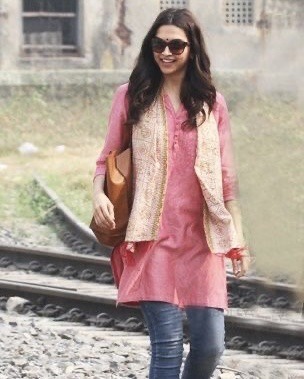

Appropriate for: Highly suitable for college or to make those trending “that girl” Instagram reels.
.•.•.•.•.•.
Outfit: A set of uttariya, antariya and kayaband, with flowers tucked in your long hair. My personal favorite.
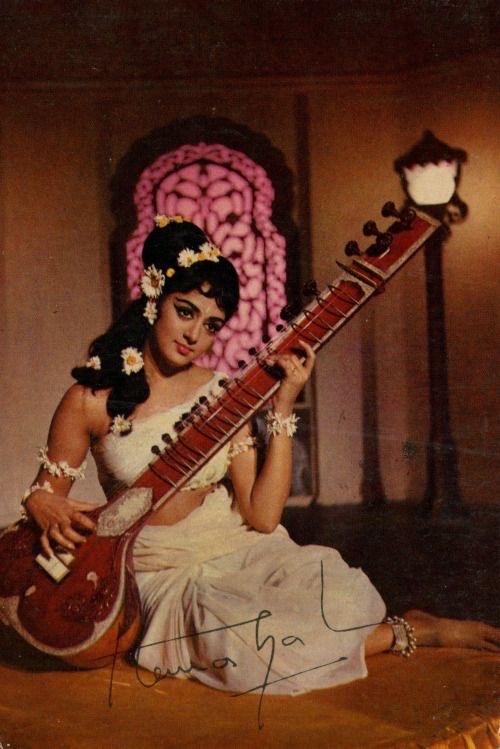

Appropriate for: Living in a small hut by a waterfall in the forest where you ( a.k.a. a mysterious maiden) rescue a wounded prince with your resplendent knowledge of jadibuties who ends up falling in love with you. ok ill stop now.
44 notes
·
View notes
Text
The Lost Flute - Part 6 (A Severed Head and Puny Chains)
After their long talk on the beach, Yashoda had practically dragged Krishna to the guest quarters. She had washed his face with cool water and massaged oil into his scalp. She fed him rotis ladled with the butter she had churned out herself earlier in the day. Eventually, Krishna had fallen asleep on her bed. Yashoda had sat on the couch, staring at his sleeping form. She could not fall asleep as Krishna's previous laments swelled in her mind. She noticed that he looked exhausted even in his sleep.
Near midnight, Krshna woke up with a jolt. Yashoda, who had dozed off on the couch, sat up straight. Krishna had woken up sweaty, clearly from a nightmare. She settled beside him, gently caressing his hair to calm him down. "What's the time?" He asked groggily, "I will get back to my chambers. I've bothered you enough for a day."
Yashoda sighed, recognizing the finality of his tone. Once Krishna made up his mind, no one could convince him otherwise. She watched as he gathered his sword and uttariya and marched out of the room. She sighed. How different was this Krishna from the young boy that had been snatched from her! Her Krishna never bothered with propriety or even basic societal rules. He was his own master, the one who lit up every room he was in! This Krishna, she found, was more cautious, more compliant, a man grieving and broken.
---
Krishna walked aimlessly through the palace corridors, careful not to wake up the sleeping guards. He turned away in disdain. The guards that were in charge of protecting his family at night, were themselves asleep. What if his lax attitude towards his servants was the sole reason that demon Shambara was able to enter his private chambers and take his firstborn? Snatching the baby right from the arms of his exhausted wife, who had lain asleep, completely defenceless that fateful afternoon! Krishna felt a rare surge of anger rise through his body. He struck his sheathed sword loudly against a pillar at the far end of the corridor. Immediately, all guards jolted awake from their slumber and assumed their positions clumsily.
"What do I pay you fools for?" He said, in a low, but carrying voice that reverberated through the long hall. It was that voice that sent chills down the spine of all listening, "If I ever see any one of you sleeping while on duty, ever again, I swear on everything that's precious to me, you will not live to see another sunrise." He finished, turning to look each of the guards in the eye.
Right then, a sweet jingle reached his ears. He turned to see Rukmini standing silently under the doorway of her chamber. Her eyes were red and swollen, but she was not crying. Then, she disappeared into the dark room just as she had appeared. Krishna mentally cursed himself for waking her up alongside the guards. Turning to glare at the guards one last time, he hurried into Rukmini's chambers.
"I apoogize, Vaidarbhi! I did not mean to wake you up." Krishna pleaded into the darkness, while his eyes adjusted, "Will someone please light a lamp," He called out. A couple of maidservants scurried in to light the lamps around the room. As light poured into the room, Krishna found Rukmini seated in silence, near the empty crib. Krishna felt like someone had torn his heart out. Rukmini's face was expressionless, but as she looked up slowly to look at her husband, her doe-like eyes betrayed her grief-stricken anger.
Krishna sat down on the floor, cautiously putting an arm around Rukmini. To his surprise, she did not protest. Krishna whispered, "I tried my best, Vaidarbhi. The parliament refused to release any more budget for the search." Krishna could feel his wife's shoulder tense up. He continued doubtfully, "But I have every one of my personal spies looking for that demon Shambara. Believe me, he will not escape me once I find him! I will avenge our Pradyumna." Rukmini shirked off his hand and went to stand by the balcony.
Krishna sighed. Rukmini was his chief wife, but she was also the youngest. Krishna had always felt a greater sense of responsibility towards her. Jambavati and Satyabhama were both far more independent and had huge, happy families surrounding them. It was only Rukmini who had left behind everything that she knew and loved without a single thought, trusting nothing but hearsay. Krishna had always harboured a pang of guilt for snatching her away from her father and brothers. The thought that he had let her down once again, and made her lose another precious piece of her heart, would not let him sleep at night. He understood her anger but also longed to be understood. Doesn't she understand his grief? He also lost his one and only child!
He quietly embraced her, enclosing her palms in his. She did not resist. The moon shined cruelly down upon them, as the uncaring ocean kept thrashing in the backdrop of the golden city that turned sans mercy.
---
At dawn, Krishna went down to the beach as usual to perform his morning worship, when an informer stopped him in his tracks, sweaty from a long run. He was annoyed but signalled at him to speak. "My Lord," panted the informant, "I have news. The demon Shambara has been slain!"
Krishna could not hide his surprise, "What?!" He exclaimed, "By whom?"
"A young boy, barely a teen! He lives with an older lady, probably a mother or sister, by the beach on the mainland up north."
"How did a young boy manage to kill such a valiant demon? Are you sure he killed the Shambara and is not trying to trick us for a reward or something?"
"No sir! He has situated himself in front of the parliament from the middle of the night, holding the severed head of Shambara! He says he will leave only after he is allowed to submit the demon's head at the feet of her grace the princess Rukmini! Several guards have tried to remove him, but he seems to be able to hold his own in battle against all of them! They say his mother is Mayavati, the black magician, maybe she helped him kill the demon!"
"Why was I not informed of this before?" Krishna asked, his eyebrows now contorted with curiosity, "How is it that a teenager is able to locate and kill a demon faster than seven hundred highly-trained royal informants?" Krishna shook his head, as he started to walk back towards the city, barking orders at the attendants in his path, "Inform brother Rama to come down to the parliament house immediately and call for Narada. I hope you will find him at least before the pralaya swallows us all!" He stopped abruptly in his tracks, "And make sure devi Rukmini is not disturbed by this news. I will let her know personally when the time is right."
---
Reaching the parliament building Krishna found the rest of the members all standing around in the street. As he approached, the crowd parted to make way for him. Before him, Krishna saw a dark-skinned young boy standing. His plain, torn clothes were bloodstained, and a tall bow hung from his shoulders. In his hands were an unsheathed sword and a severed bloodied head. His eyes were bright, and his stance defiant. For a split second, Krishna saw himself from almost a yuga before, standing defiant before the tyrant king Kamsa, holding a bloodied elephant tusk upon his shoulders, his right foot upon the neck of a dead royal wrestler.
Krishna's trance was broken by a familiar hand on his shoulder. He turned to find Balarama standing beside him, holding his famous mace. With a slight indication, Krishna stopped Balarama from advancing. He unsheathed his own sword and spoke directly to the boy standing before them, "I do not wish to fight you, boy! If you also want peace, then on the count of three we will both drop our weapons." The boy nodded cautiously.
The moment the boy dropped his sword, a bunch of guards captured him at Krishna's command. "That is not fair, I helped you!" The boy screamed, struggling against his captors.
"Life rarely is," sighed Krishna and indicated to the guards to take the boy inside the parliament house. Once all members were inside, the door of the parliament was sealed shut, and at Krishna's indication, the guards released the boy. Krishna sat down beside Balarama with his sword still unsheathed. Now the boy stood quietly, understanding his predicament.
"Who are you, and how dare you create a ruckus in the middle of the town square?" Roared Kritavarma.
"I'm nobody. I came to help out the royal family of Dwarika since they seem to be unable to help themselves!" The boy replied, defiance still dripping from his tone. Balarama, leapt from his seat to attack him, but Krishna pulled him back.
"What gave you that impression?" Krishna asked with a hint of amusement in his tone.
"A demon defiled the sanctity of your private chambers and insulted both you and Mother Rukmini by taking and murdering your child. Yet, I didn't find the entire Yadava army marching down our village seeking revenge. I felt like the women of our land deserve better, so I went and did what had to be done!" Krishna was taken slightly by surprise. Just the previous day, he had stood in this very room, arguing the same points in vain, and yet this young man had the courage to go out and just do what needed to be done!
Meanwhile, the entire group of parliamentarians had broken into a chaotic conversation, their opinions ranging from steep prizes to death penalties. "QUIET!" The room fell silent as Balarama's powerful voice reverberated across the marble walls. "What do you want from us?" He asked the boy.
"As I've been saying for the past six hours, I want to meet mother Rukmini and present her with this severed head of the demon that took her child from her!" The boy declared.
Krishna took a long breath, to quiet his screaming heart. Then he spoke to the boy directly, "I agree with you that a grave injustice has been done to devi Vaidarbhi. I thank you from the bottom of my heart on behalf of my family for avenging our Pradyumna, the light of our lives. However, I must beseech you to consider if this gory display is the best thing to gift a grieving woman who has just lost her one and only child anew today, his passing marked in stone with your appearance."
The boy lowered his head, seeming regretful for the first time. The entire sabha had also fallen silent, with each and every member pondering, maybe for the first time, the human response to the tragedy.
Suddenly the quiet of the room was broken by the clanking of castanets as Rishi Narad entered the parliament sabha. Krishna nodded slightly as the junior ministers quickly jumped to their feet, making way for the jovial ascetic. Once seated, Narad spoke, "Hello Krishna! Your attendants were kind enough to pick me up without any prior message, from an acquaintance's ashram in Prabhas, and drag my old body down here atop a horse!"
Krishna smirked at the veiled complaint, "Let's not get into all that now, Devarshi." He continued pleasantly, "Currently, the matter of most urgency is this extremely confident young man."
The boy broke into a big smile on cue, right as he was mentioned. Krishna raised an eyebrow at Balarama, who shrugged back in response, "Well, don't pretend you're not the same!" He whispered to his younger brother.
Narad laughed at the brothers' exchange, "Gentlemen! This young man right here is none other than Manmatha! I have named him thus myself. His parents had both perished at his birth, and the kind lady Mayavati has nurtured and educated him since. He is deeply devoted to both Lord Krishna and his consort devi Rukmini, hence he might have committed a few blunders in his haste to seek revenge on behalf of his idols. This brings me to my concern. A divine ordinance has been received by several esteemed rishis, including myself. The demon Shambara must perish at the hands of Pradyumna, the son of Prince Krishna and devi Rukmini. This was the same ordinance that Shambara attempted to defy when he kidnapped the newborn prince. Now, as it stands this ordinance has been proven wrong by Manmatha."
Balarama drew a sharp breath, "So, now the credibility of all rishis is compromised!" Narad nodded seriously.
"So what now?" Asked Satrajit.
Narad smiled, "Simple. This is a closed chamber, I am an ordained priest. Let the Prince and Princess adopt this lad at this moment, within the confines of this sabha, and let him be known hereafter as the lost Prince Pradyumna that has returned home by God's grace."
"Are you kidding me?!" Krishna spoke before anyone could react, "I haven't even had a single day to process the fact that my child is dead, my wife has no clue whatsoever of this whole mess here, and you seriously expect us to just replace our firstborn?!"
Narad spoke calmly, "Think it over, Prince. You are smart enough to know why I said what I said. Your life is much too important to be tied to simple familial emotions. Shirk off these puny chains, Prince, and do what is right!" Narada leaned closer, hovering over Krishna as he continued in a hushed tone, "An entire generation looks to you, Prince. You will succeed at your mission only with true friends at your side because you and I both know family doesn't work out. Look around you, which of these uncles and cousins, your blood relatives, are truly on your side? You know which ones will stab you in the back, and the ones that are circling you and your wives like hyenas. Trust me, you do not need young Manmatha as your enemy. He can defeat even Lord Kartikeya in battle, and as it stands now he will gladly give his life if you so command. Think before you reject him!"
Out of the corner of his eyes, Krishna looked at the young boy who still stood holding the severed head of the demon. He was clearly rattled by the abrupt turn of events. Krishna spoke, his voice barely above a whisper, "I shall accept only if devi Rukmini also chooses to accept young Manmatha as her firstborn and the heir to the throne."
#krishna#hindu mythology#balarama#fanfic#original writing#india#subhadra#vrindavan#mahabharata#the lost flute
9 notes
·
View notes
Text
Unveiling the Splendor of Ancient Indian Clothing and Style
India's rich history is adorned with a tapestry of clothing and fashion that has evolved over the centuries. From the Vedic times to the Indus Valley civilization, the clothing of ancient India tells a captivating story of tradition, culture, and artistry. In this blog post, we dive into the remarkable world of ancient Indian clothing, exploring the styles, fabrics, and colors that adorned both men and women. Let's embark on a journey back in time to discover the fascinating attire that shaped the fashion landscape of ancient India.

Clothing and Style for Men:
Dhoti: A cloth wrapped around the waist and knotted at the back.

Antariya: A white cotton or muslin cloth tied to the waist, accompanied by a sash called Kayabandh and a scarf called Uttariya.

Turban: A cloth wrapped around the head, often symbolizing social status and identity.

Phetas: Special turbans worn for religious purposes.
There are numerous types of phetas which are being used in different places across India for different purposes.
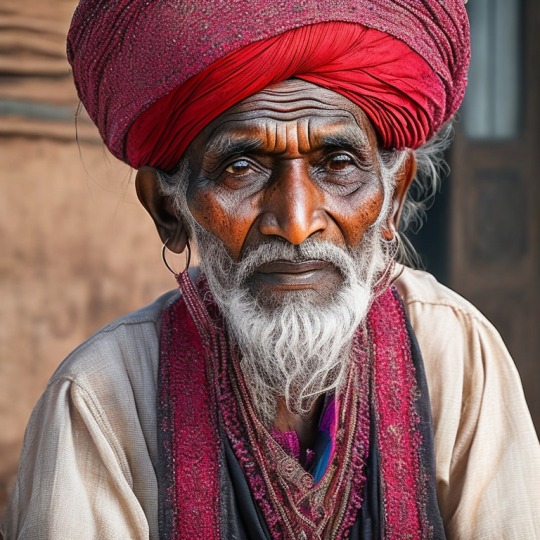
Peplon or chiton: Layered clothing made of linen and wool, adjusted according to weather conditions.

Man-buns and short or shaved beards were popular styles

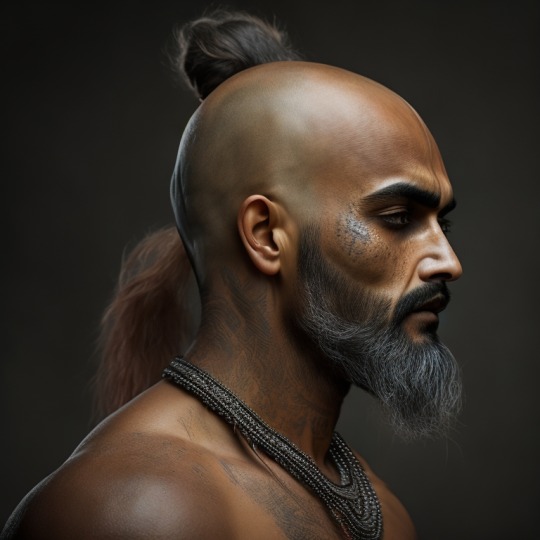
Clothing and Style for Women:
- Sari: A long piece of cloth draped around the body and over the head, showcasing elegance and grace
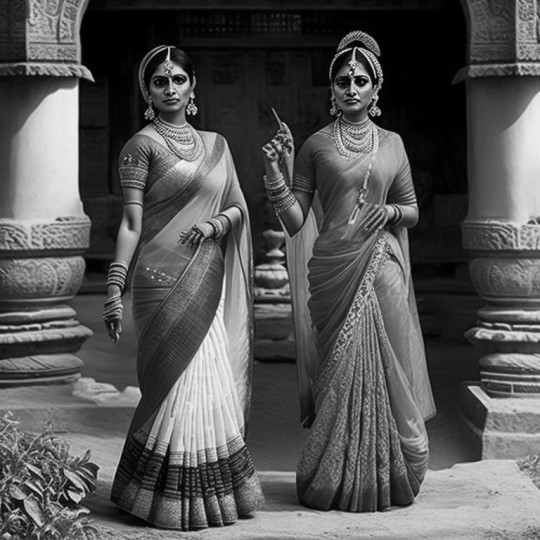
Knee-length skirts paired with intricate jewelry like bangles, earrings, and beaded necklaces.
- Elaborate jewelry made of stones, animal claws, feathers, and shells.
- Handloom textiles woven by skilled artisans.

- Gold ornaments, particularly worn by upper castes.
Sirradai: A short lower garment made of handspun cotton and silk.

Traditional Colors Used in Ancient Indian Clothing:
Ancient Indians were adept at dyeing clothes, and specific colors held symbolic significance:
- Ivory, jasmine, August moon, August clouds after the monsoon, and the color of the peacock's neck were significant traditional colors.
- The Vedic treatise Vishnudharmottara described these hues.
Traditional clothing of india
Men wore a variety of garments depending on their region, occupation, and social status. Some common examples include:
Lungi: A simple garment made of a single piece of cloth wrapped around the waist and legs, similar to a sarong.

Veshti: A long piece of cloth wrapped around the waist and legs, similar to a dhoti but without the pleats.

Angrakha: A long tunic with a V-shaped neckline that is worn over a dhoti or other lower garment.
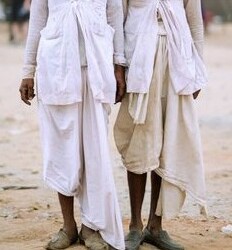
Sherwani: A long coat-like garment that was often worn for formal occasions.


Pajama: Loose-fitting pants that are typically worn with a kurta or other upper garment.
It's worth noting that the styles and materials of these garments varied widely depending on the time period and region in which they were worn.
Conclusion:
Ancient Indian clothing showcased the richness of culture, history, and artistry. Through the ages, men and women draped themselves in garments like dhotis, saris, turbans, and knee-length skirts, reflecting their customs, traditions, and social status. Warriors donned armor and wielded weapons as they protected their kingdoms. The vibrant colors derived from natural elements added splendor to the attire. The remnants of ancient Indian clothing, discovered through sculptures, paintings, and literature, provide us with a glimpse into the past, where clothing was not merely functional but also an expression of identity and heritage.
#beautyofindia #indianclothing #indianimpact #indianhertage#forgottenbharat
3 notes
·
View notes
Text
Fashion Meets Ethnicity!!
India is the most diverse nation in the world. There is a lot of diversity in culture, religion, language, food, fashion, etc. People here live together and respect each other’s customs and it's true that “Unity in Diversity” is the unique feature of our country.
When it comes to fashion, India has it all. Due to its diversified culture, we have a wide variety of fashion from traditional Indian dresses to western wear. This trend has given birth to a fashion trend called the Indo-Western Fusion Style. Nowadays, Indian women want to prefer fashion that is stylish yet traditional. This is where Fashion meets Ethnicity!!!
Lehenga Choli is one such kind of outfit that Indian women cannot avoid. Weddings or Festivals, it is incomplete without Lehengas for Indian women. It is a beautiful three-piece traditional attire that is usually preferred amongst the older and the new generation equally in India. Traditionally, this three-piece attire has an Antriya which is the lower garment from which Ghagra and Dhoti emerged, the Stanapatta which later on became the blouse and the Uttariya, which is the piece of cloth used for covering the head and the shoulder. The Uttariya is the modern-day Dupatta. This traditional outfit saw many transformations and evolved over time into the modern-day Lehenga Choli.
Madhusmithastore always endeavors to give the best to its customers. Madhusmitha cares about its customers' needs and caters to the same. The Lehenga collection includes traditional as well as stylish Lehengas in customizable sizes and Lehengas come in various fabrics and patterns.
Their best-selling product is the Banarasi Art Silk woven Semi-stitched Lehenga Choli with Satin lining in multiple colors with matching/contrasting dupatta which I would really recommend to anyone. The fabric and their designs are too good. The set consists of a Blouse/Choli made of Cotton silk with a matching or contrasting dupatta in Silk/Net fabric. The Net dupatta has peal embroidery on it and the Silk dupatta has golden shiny work. The Lehengas come in multiple colors and fabrics at an affordable price. The price of this Banarasi Silk Lehenga is starting from Rs.2450/- only. This is the best website that provides the best Lehenga Choli under Rs. 5000/-. Madhusmitha always helps to bring out the Indian charm in us during weddings, engagements, or festivals like Diwali, Dussehra, Sankranti, etc.
They also have a Bridal Semi-stitched Lehenga Choli set which is as cheap as Rs.8500/-.The fabric used for the Lehenga-Choli and Dupatta is 100% Jacquard and the size of the product is customizable as the Lehenga is semi-stitched and the blouse is unstitched. This product has one Lehenga, one Choli, and one Blouse piece in the set. They have the best Bridal Lehenga collection online at affordable prices.
Madhusmithastore also has a good collection of matching accessories at affordable prices that can be purchased along with the Lehengas. We can buy both lehengas and jewelry from the same store which can save a lot of our time. Enjoy Shopping with Madhusmitha!!!
Do visit their website https://madhusmitha.com
3 notes
·
View notes
Text
2 notes
·
View notes
Text
The Rise of Silk Dupattas
In the vibrant tapestry of Indian culture, countless threads of tradition exist, each weaving a unique story of heritage and history. Among these threads, the dupatta stands out as a symbol of grace, modesty, and tradition. Over the centuries, the humble dupatta has evolved from a simple piece of cloth into a versatile fashion statement, embracing innovation while preserving its cultural significance. In this exploration, we delve into the fascinating journey of the silk dupatta and how it has become a must-have accessory for modern Indian women while maintaining its deep-rooted ties to tradition.
The Origins of Dupattas
The origins of the dupatta can be traced back to ancient India, where it was initially known as "uttariya." In its earliest form, the uttariya was a length of fabric draped over the shoulders, covering the upper body. It was primarily a symbol of modesty and respect, reflecting the cultural values of the time. The uttariya was commonly worn by men and women and came in various materials, including cotton and silk.
Evolution in Fabric: The Rise of Silk Dupattas
As time passed and Indian culture continued to evolve, so did the uttariya. One of the most significant transformations was the introduction of silk fabric. With its luxurious texture and vibrant sheen, silk quickly gained popularity among the elite and royals. The silk dupatta, with its soft drape and elegant appeal, became a status symbol and a symbol of luxury. Silk dupattas were often woven with intricate designs, ranging from traditional motifs to floral patterns, reflecting the rich heritage of Indian craftsmanship. The use of silk in dupattas elevated their aesthetic appeal and made them more comfortable to wear, especially in the scorching Indian summers.
Cultural Significance of Silk Dupattas
Silk dupattas played a crucial role in various aspects of Indian culture. They were integral to traditional attire, often paired with salwar kameez, sarees, or lehengas. Each region of India had its unique way of draping the silk dupatta, adding a distinctive touch to the ensemble. Beyond its role in clothing, the silk dupatta held more profound cultural significance. It was often gifted during weddings and other special occasions to symbolise blessing and good fortune. The intricate embroidery and handwork on silk dupattas made them highly prized heirlooms, passed down through generations as cherished family treasures.
The Revival of Traditional Artistry
In recent years, there has been a resurgence of interest in traditional craftsmanship, and silk dupattas have played a pivotal role in this revival. Artisans and weavers across India have embraced age-old techniques to create exquisite silk dupattas that highlight the beauty of Indian handwork.
Handwoven silk dupattas, adorned with intricate embroidery, zari work, and mirror embellishments, have gained recognition in India and on the global fashion stage. This revival not only preserves traditional skills but also provides a source of livelihood for countless artisans, ensuring the continuity of their craft.
Versatility Meets Modernity
While silk dupattas maintain their cultural roots, they have also adapted to modern fashion trends. Today, silk dupattas are no longer confined to traditional occasions; they have become versatile accessories that can be styled in several ways. One of the trends that has gained popularity is pairing a silk dupatta with Western attire. A silk dupatta draped over a simple dress or paired with jeans and a top adds a touch of elegance and ethnicity to a contemporary look. This fusion of traditional and modern styles has made silk dupattas a fashion statement that transcends cultural boundaries.
The Influence of Bollywood
The Bollywood film industry has played a significant role in popularising silk dupattas and displaying their versatility in films. Iconic Bollywood actors have often adorned silk dupattas in numerous ways, from the classic drape to innovative, experimental styles. These cinematic influences have spurred fashion enthusiasts to experiment with silk dupattas in their unique ways.
The Digital Age
Buying a silk dupatta has always been challenging in today's digital age. With the rise of e-commerce platforms, one can explore a vast array of silk dupattas from the comfort of their home. Online marketplaces offer a wide selection of silk dupattas in diverse colours, designs, and price ranges, making them accessible to various consumers. Moreover, the online space provides a platform for artisans and weavers to showcase their creations to a global audience. This boosts their sales and fosters a deeper appreciation for the craftsmanship behind each silk dupatta.
Conclusion
The evolution of the silk dupatta from a symbol of tradition to a versatile fashion statement is a testament to the resilience of Indian culture. It has seamlessly adapted to changing times while preserving its rich heritage. Today, the silk dupatta is not just an accessory; it reflects India's diverse traditions and embraces modernity. Whether draped traditionally or draped over contemporary attire, the silk dupatta continues to weave its story, connecting the past to the present and bridging cultures in a tapestry of elegance and grace. So, if you want to buy a silk dupatta, remember that you are not just acquiring a piece of clothing but embracing a piece of India's rich cultural heritage.
0 notes
Text
Buddhist Clothing
Draped clothing:
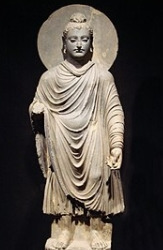
A draped garment is one that is composed of a single piece of material that is draped around the body rather than being cut away or sewn as is the case with a fitted garment. Drapes can be fastened to the body by knotting, pinning, fibulae, clasps, sashes, belts, tying drawstrings, or simply friction and gravity. Many draped clothing are made out of simply one piece.
Kasaya (clothing)
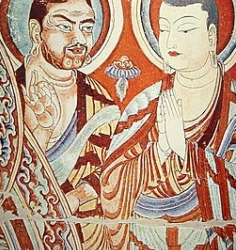
The robes of fully ordained Buddhist monks and nuns are called kya, after a brown or saffron hue. In Sanskrit and Pali, these garments are sometimes referred to by the more generic name cvara, which refers to the robes regardless of colour.
Pratheedhi
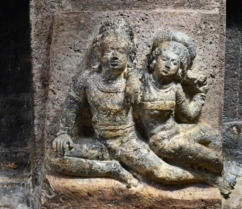
Pratheedhi, a loose garment was a part of the bride’s attire made of simple strip of cloth. Pratidhi was an unstitched garment similar to almost all contemporary clothes that were wrapped around the body in different ways. The women were fastening it up at the back. The materials were usually animal skin, cotton, wool, or silk.
Rakusu
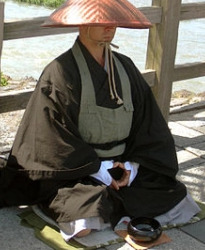
A rakusu (絡子) is a traditionally Japanese garment worn around the neck of Zen Buddhists who have taken the precepts. It can also signify Lay Ordination. It is made of 16 or more strips of cloth, sewn together into a brick-like pattern by the student during their period of preparation for their jukai or ordination ceremony.
Samue
youtube

Samue (作務衣) is the work clothing of Japanese Buddhist monks, worn when engaged in samu.
Sang-kio-ki
Sang-kio-ki and "Ni-fo-si-na" were ramaa people's costumes in India. The Chinese traveller Xuanzang characterised Sramana's clothes in the 7th century as three distinct sorts of robes, each with a different style and cut according on the school they belonged to. Some robes feature huge or small flaps, while others have narrow or wide borders. The Sang-kio-ki conceals the two armpits while covering the left shoulder. It is worn closed on the right side and open on the left. It is longer all the way down to the waist. The Ni-fo-si-na was a loin garment that was plaited in folds and corded around the loins. There are no tassels or griddles on it. Different schools used various hues.
Stanapatta
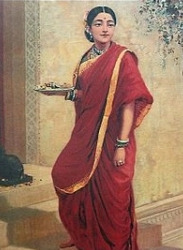
Stanapatta (Stanmasuka) was a loose upper body wrap fabric. It was an old Indian breast band. It was a basic top garment worn by women in ancient times, akin to the mamillare or strophium used by Roman ladies. Poshak included Stanapatta. Klidsa describes kurpasika, another type of breastband that he associates with uttarasanga and stanapatta. Innerwear for the lower body was known as nivi or nivi bandha. Malhar's Skandamata sculpture portrays the ancient use of stanapatta and kanchuki.
Temple robes
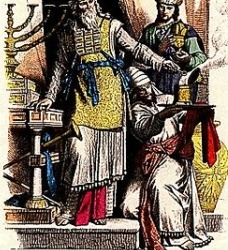
Temple robes describe the ceremonial clothing worn in the performance of ordinances and ceremonies in a temple.
Uttariya
An uttariya is a loose piece of upper body clothing. It is a single piece of cloth that falls from the back of the neck to curl around both arms and could also drape the top half of the body. An Uttariya is similar to a veil, a long scarf and shawl.
Referencing:
Pratima. (2022). Buddhist religious clothing, amulets & talismans. [Online]. mandalas. Last Updated: 28 December 2022. Available at: https://mandalas.life/list/buddhist-religious-clothing-amulets-talismans/ [Accessed 18 September 2023].
1 note
·
View note
Text
Evolution Of The Indian Saree Throughout The Years
History Of Saree
Saree has existed for almost 5000 years, dating back to the Indus Valley culture (3300-1300 B.C.E.). One of the oldest clothing items still in use today is the Indian saree.
A lot of people think that in the second century BC, Alexander the Great brought this article of clothing to India. Many Greek women in the Mauryan court wore a long piece of fabric called a "Chiton," which was thrown over one shoulder, and the rest was used as a pleated skirt. A large number of Mauryan emperors wed Greek women. This had an impact on South Asia's and India's fashion.
Many Indian goddesses are pictured wearing sarees, and a saree is likewise seen as a tribute to the gods. A traditional dress in India, Sri Lanka, Pakistan, Bangladesh, and Nepal is the Saree or saree. It is still popular for daily or special wear among Indian women. Indian ladies believe that wearing a saree, jewellery, and a Bindi on her forehead is the epitome of feminity.
The Traditional Indian Saree
The Sanskrit word "Saadi," which refers to the Sattika fabric type, is where the word "saree" first appeared. Hindu scripture claims that Sattika is the culmination of a three-piece ensemble. This consists of the Stanapatta, a chest band, the Uttariya, a veil worn over the shoulder, and the Antriya, the lower clothing.
This entire ensemble is known as poshak, a general name for a costume. Antaria later developed into the Bhairnivasani skirt known today as the Lehenga or Ghaghra. By the first century, the stanpatta had developed into a bodice, and the northern, uttariya which was worn as a veil over the head now, had become the dupatta.
Evolution Of The Saree
After surviving hundreds of years of changes, invasions, colonizations, and globalization, the saree has now become a much-coveted, elegant, and sexy attire that women wear all over the world.
The saree gives an unparalleled sense of luxury, grace, elegance, and femininity. When wrapped properly, a saree can enhance the female shape. Whether on the red carpet, at a friend's wedding, or at a workplace party, a saree is unquestionably a head-turner.
The most adaptable clothing is undoubtedly a saree. The same saree can be styled in various ways, paired with various shirts, even pants, and ornamented in various ways. Sarees exist in various materials, colours, and patterns, with varied prints, work, and more. By getting a few, essential designer Indian sarees online, one can have an incredibly diverse wardrobe.
Several factors explain why sarees have remained popular as clothing items for ages.
It is versatile
A saree can be draped or worn in a variety of ways. There are as many diverse draping styles in India as there are states. Some examples include the Gujarati draping style, the Rajasthani draping style, the Bengali draping style, the Maharashtrian style of wearing saree, Styles from the South, etc. In addition to the conventional styles, one might experiment with brand-new approaches. Even the more established traditional looks can be worn now with the available one-minute saree in U.S.A.
It has a sensual, sexual appeal
No other garment flatters the female body as the saree, and the fluidity of the drape gives the wearer a very feminine and sensual appeal. There is a saree for practically every occasion, whether it is an office party, a festival, a special supper for two, a wedding, a get-together with friends, etc. You can get designer Indian sarees online that can be adorned in several ways to seem festive or casual.
It is high in glamour quotient
When wearing a saree, one feels regal and glamorous. The saree is lavish and flamboyant.
It comes in many varieties
It is available in a wide range of materials, colours, works, and styles. It can be worn with a variety of blouses. Designers are continually reworking and reinventing it, making it more and more modern. The latest is a one-minute saree in U.S.A., which makes it easier to wear for people who do not know how to drape a saree.
The saree has dominated the runway and is poised to rule the world thanks to its beauty, adaptability, and grace. In light of this, the saree will continue to leave its imprint on the fashion world for many years to come for the same reasons it has stood the test of time.
0 notes
Photo

#ila #mahabharat #queer #theatrelife🎭 #livesinging #jadabpurmanthan #costume #ethnicwear #headgear #uttariya #desimodel #desimen #bengalidrama #kathakata #pecs (at Tripti Mitra Natya Griha, Paschimbanga Natya Academy) https://www.instagram.com/p/CMAc8xalsCU/?igshid=1ouu5tl3bx8g4
#ila#mahabharat#queer#theatrelife🎭#livesinging#jadabpurmanthan#costume#ethnicwear#headgear#uttariya#desimodel#desimen#bengalidrama#kathakata#pecs
0 notes
Link

Buy prime collections of jamdani sarees from online store Uttariya. We have a huge collection of Jamdani Sarees, Dhakai jamdani Sarees with multiple colors and latest design. Choose from the various variety of sarees. We provide 100% best quality products to our customers with Free Shipping! Cash on Delivery! Worldwide Shipping! Easy Exchange Policy!
0 notes
Photo
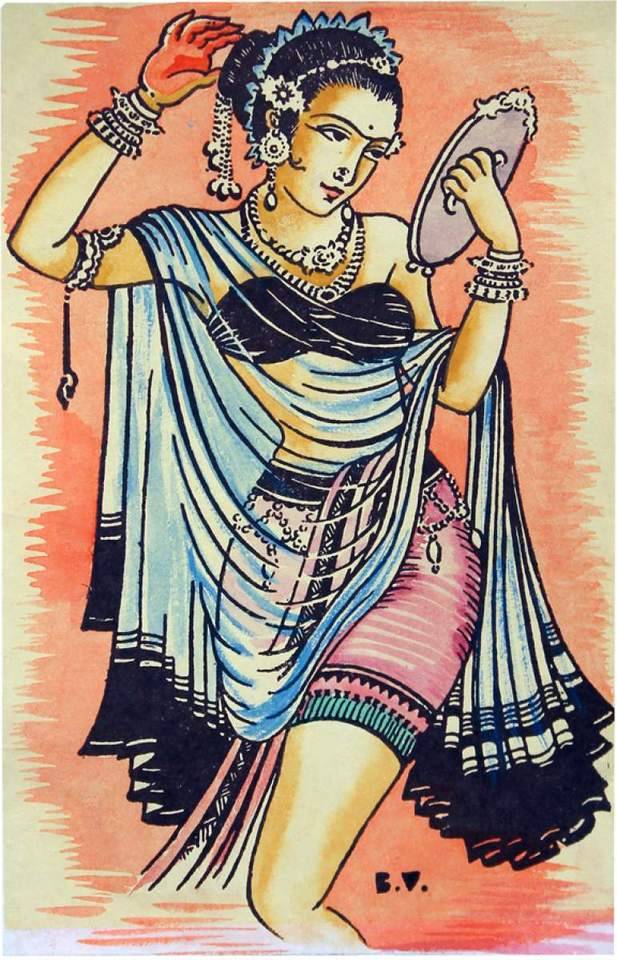
Of course it is impossible in cold countries to display the beauty of ornaments, which have to be worn on the bare body, for if they did so they would suffer severely from cold. So the fondness for ornaments is transferred to, and is satisfied by, the niceties of dress. As in India the fashions in ornaments change very often, so in the West the fashions in dress change every moment. Civilisation and Dress, Swami Vivekananda: Complete Works.
Vivekananda’s perspective on the Indian use of jewellery and how it has multiple meanings regarding style, status and the like.
Today is Yuva Diwas/National Youth Day.
The artwork is Palli Badhu (Village Bride) - described as a watercolour on silk, in the wash style that features a bride with embellishments against a lightly coloured sari - by the Odia painter Bimbadhar Varma. Via IPCA.
#swami vivekananda#national youth day#indian art#vintage art#village bride#indian jewellery#odia art#uttariya antariya#indian costume#bimbadhar varma
171 notes
·
View notes
Text
The Magic Of Benaras
It was 6.30 P.M, Godowlia Chawk, Benaras; I was rushing through the huge rush of people heading towards the Dashashwamedh ghat. I was taking a serpentine move through the shoulder-to-shoulder crowd at the Godowlia Chawk. It’s time for the Ganga aarti, a shining beacon of bliss and devotion in and around Varanasi.
I could see a sea of people ahead of me towards the Dashashwamedh ghat. The shops on both the sides were lit with dazzling lights, the shopkeepers were screaming on the top of their voices to entice the pedestrians into their shops of ‘benarasi dresses, sarees and fabrics’. People were pouring in the brightly lit Vishwanath gali for the rainbow coloured ‘minakari’ and stone-setting ‘benarasi churis’ (bangles) and a variety of ‘benarasi pan masalas’ or mouth freshners, puja items and utensils made of brass and copper. Large number of people were gobbling down a variety of ‘chaats’ (snacks) or drinking hot ‘benarasi chai malai mar ke’ (tea with cream) crowding before the chaat centres.



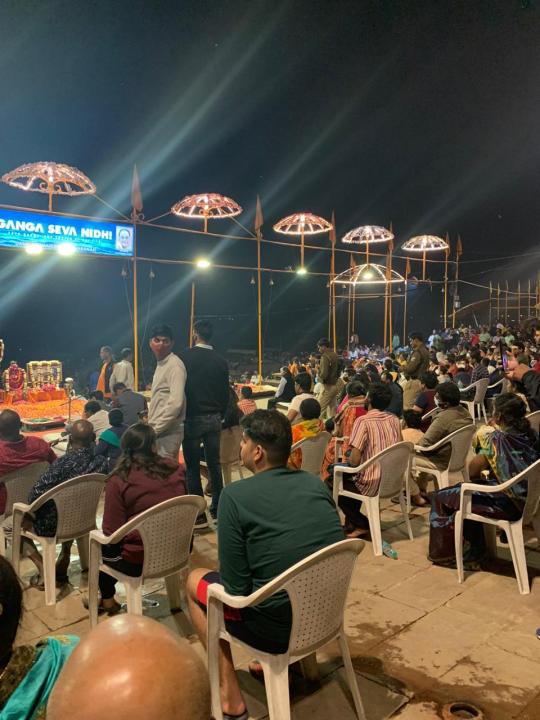


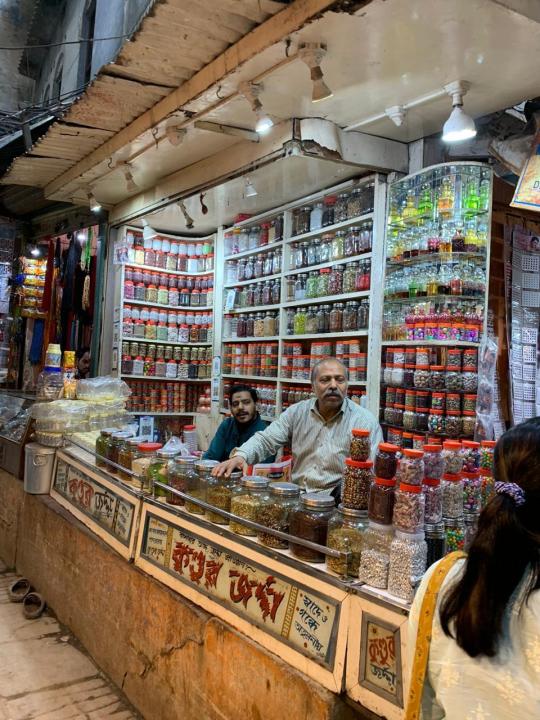
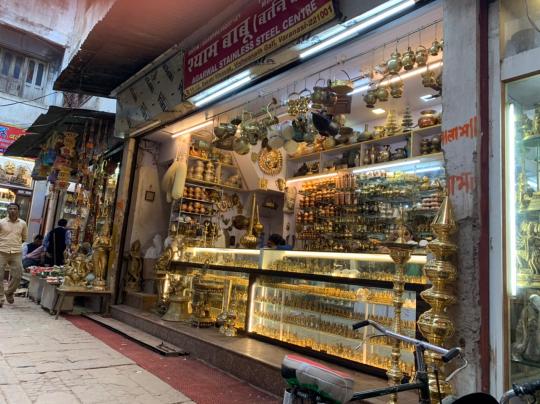
I was practically pulled by the waves of the crowd towards the Dashashwamedh ghat; it was almost the time for the Ganga aarti and I was in no mood to miss it. The steep steps of the ghats connecting the Ganges with the city are the venue for the much-captured sights and sounds of the Ganga aarti. I have much heard about the Ganga aarti from my parents and my grand-parents, that is a visual one must feast upon. As I was tripping down the stairs of the Dashashwamedh ghat, I saw hundreds of people before me raising their hands high in the air echoing, “Har Har Mahadev” from one end of the ghat to the other. The blowing of conch shells by half a dozen of pandits (priests) to mark the start of the aarti awoke an adrenaline rush in me. I raised my hands too, uttering “Har Har Mahadev”. All the 6 priests blew the conch shells to sanctify the atmosphere followed by the waving of the incense sticks to worship the Ganges.
At dawn in the Vishwanath temple, the chanting of “jai Baba Bholenath” sends a kind of bliss and peacefulness to the soul. But, during the Ganga aarti in the evening the chanting of “Har Har Mahadev” and “Shiv Tandav Strotam” (which highlights the worship of Lord Shiva) brings goose bumps to the whole body.
The whole aura of the ghat differs so much from morning to evening each having a distinction of its own. At the wake of the dawn, the pandits perform puja rituals for the young, old and the kids sitting under their respective ‘chhattris’ (umbrellas); perform ‘shraddh s’ for the dead; ‘mundun’ (shaving of the head) for the new born babies; ‘pushpanjali’ (worshipping the river with flowers) to the river implying respect and worship to Mother Ganges. It’s a joy to behold flower bowls with lighted candles floating in the river; the pandits drawing “haldo-chandan tilak’ (3 parallel lines of turmeric and sandalwood) efficiently with their 3 fingers with a red ‘sindoor tika’ (red dot) at the centre of the forehead of the tourists in the name of Lord Shiva; the boats crossing the Ganges with full of tourists enjoying the morning view; newly married couples taking blessing of the Mother Ganges and Lord Shiva by sprinkling holy ‘ganga-jal’ (holy water of the Ganges) on them; people taking holy dip in the Ganges during morning bathing; the professional photographers remain busy either in pestering the tourists or taking pictures of them. At the back of everything the sweet jingling of the tolling of the temple bells can be heard for hours. Dashashwamedh ghat thus, in the morning looks quite busy yet an epitome of tranquility and serenity. But, in the evening at the Ganga aarti, Lord Shiva is worshipped much vigour and valour. The ghat looks gorgeous with luminous lightshades, brightly dressed priests, sharp sounds of conch shells and the spiral smoke emerging up in the air from the incense sticks.


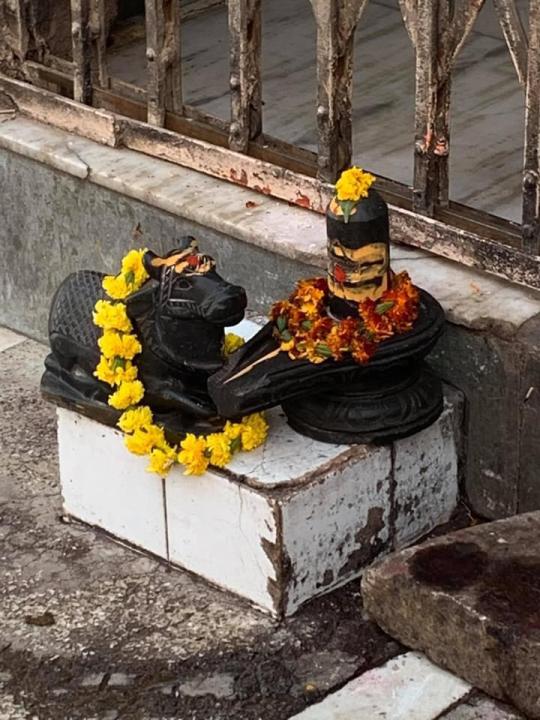
(idols of God in every nook and corner of the ghats)

(boats moored at the riverfront)

(’mundun’ of a young boy)
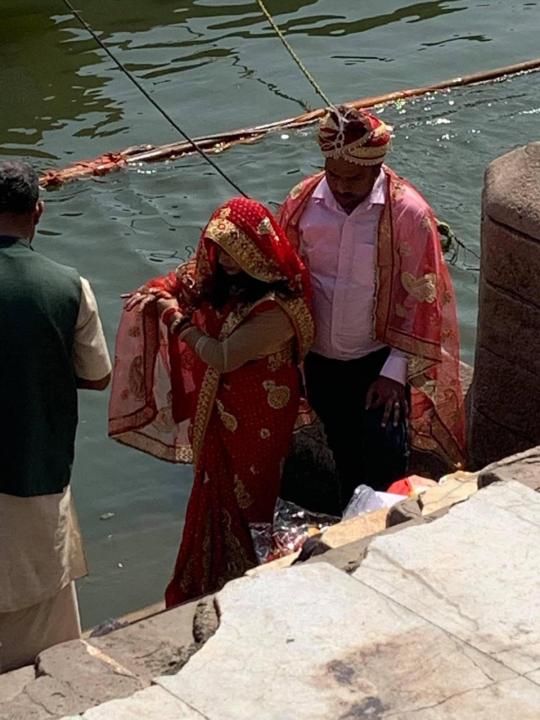
(newly wedded couple at the Dashashwamedh ghat)

(men getting prepared for their morning dips at the Ganges)
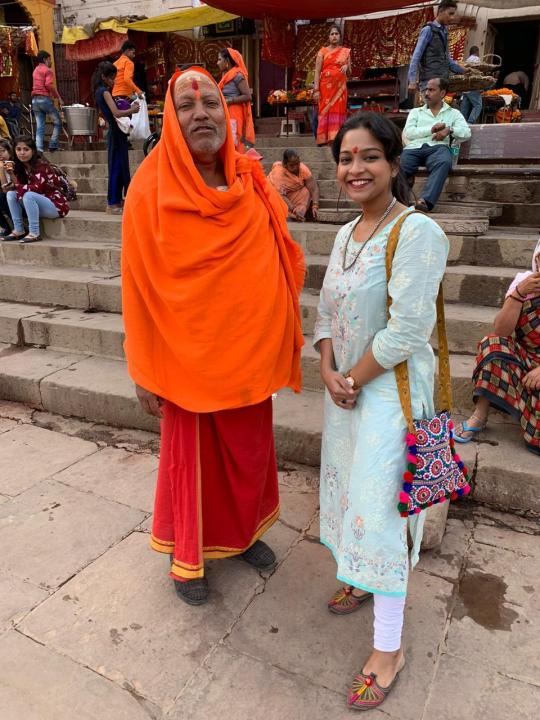
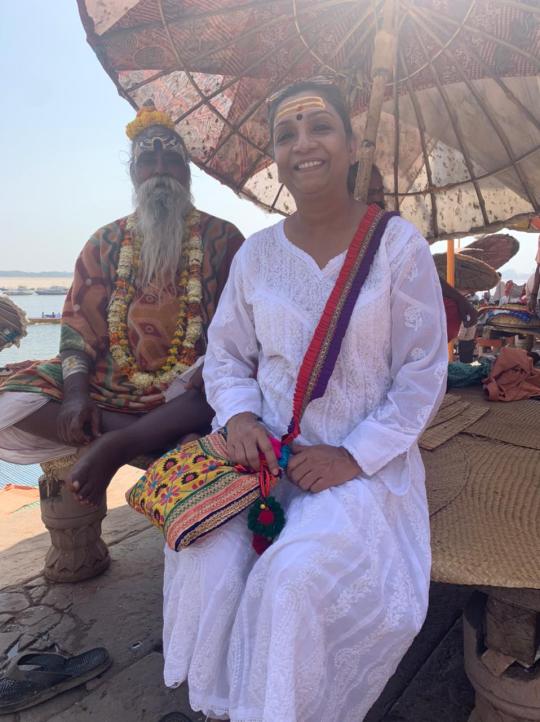
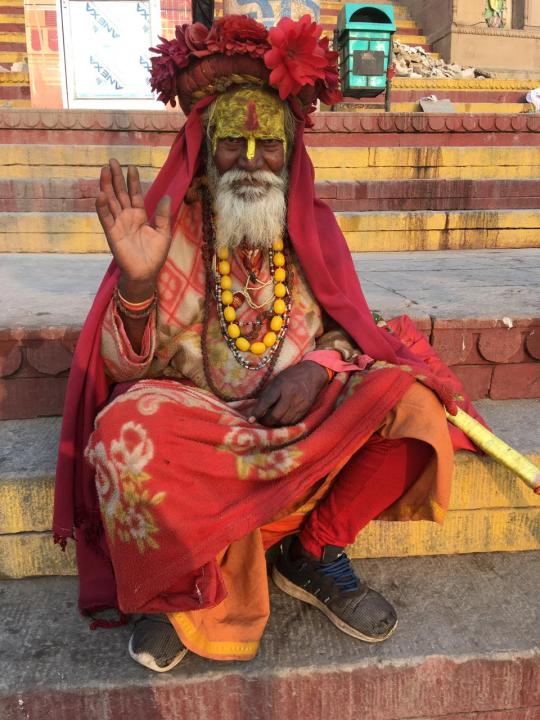
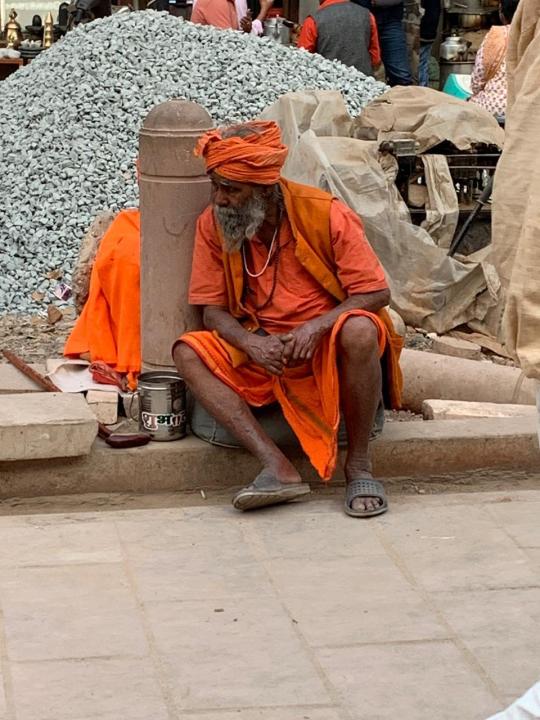
(’sadhus’ and ‘aghoris’)


(My mother seeking blessings from Ma Ganga)
The young energetic pandits in charge of performing the aarti wear red silk ‘dhotis’ with rich gold borders, red kurtas with red ‘uttariya s’ (stoles) across their shoulders. It’s an awe-inspiring spectacle to watch and hear the chanting hymns and the twists and turns of the hands holding the multi-tiered ceremonial brass lamps by all the 6 priests together. As the Ganga aarti is performed in all the ghats in the same time, the most amazing part is the sound of the chanting of mantras echoing through the whole river and the ghats at the same hour. Even after the end of the Ganga aarti the ‘Shiv Tandav Strotam’, the blowing of several conch shells together were still buzzing in my ears; I can yet envision the thick smoke rising from the giant snake-shaped brass lamps and the wavering of the large peacock feathers by the dancing hands and the swinging bodies of the gorgeously dressed pandits. All this kept me in a trance for several hours.

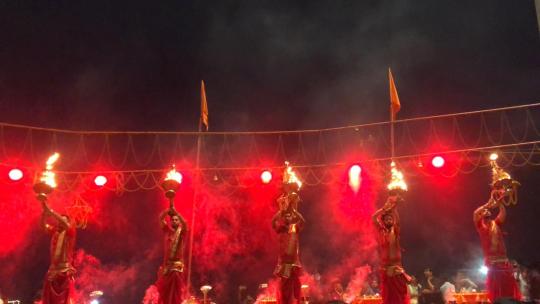


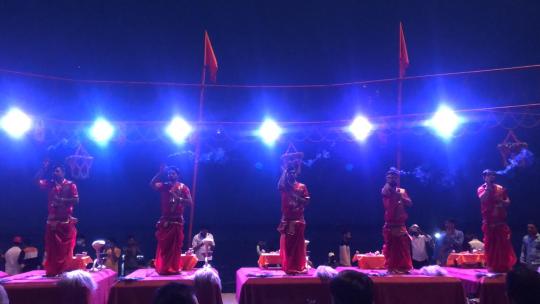
The Ganga aarti by these pandits all together create a magic of light and shade and smoke highlighting the worship of Lord Shiva. Whereas these pandits in the morning at the same ghat simply create an aura of spirituality invoking a kind of peacefulness and calmness of soul by their regular methodical religious rituals in the ghats.
6 notes
·
View notes
Text
Engagement lehenga
It's very much utilized as the underside part of a Gagra choli or Langa Voni. It's checked in the midriff and leaves the back and waist uncovered. From the Indian subcontinent, diverse sorts of incredible weaving work are done on lehenga, with Gota patti weaving being among standard kinds for its weddings and festivities. The wellspring of contemporary Lehenga can be pursued once again into mughal age . It had been toward the beginning worn just by young women in Mughal age. [4] During the tenth century, Lehenga choli ended up pervasive as a clothing among young women generally in North India. It created through charming craftsmanship with the section of Mughals at India and their following standard from the sixteenth to the eighteenth century.
Back in Punjab it had been generally worn with all the kurti and salwar. In Maharashtra it's usually called as Parkar Polka it's a combo of this gagra or lehenga (long skirt) similarly as in like manner the choli (shirt).
By and large, the gagra choli progressed from the three-piece dress worn by women in India. The garments involved this antriya lower bit of attire, the uttariya spread worn on shoulder or head close by stanapatta a chestband, which finds referenced in Sanskrit composing and Buddhist Pali composing in the midst of the 6th century B.C.
It created from the early Stanapatta (generally called Kanchuki) and can be cut to fit close to the body with its short sleeves and reduced neck. The choli is regularly altered, allowing presentation of this navel; the cut arrangement is particularly proper for wear at the sweltering summers of this Indian subcontinent. Gagra[edit] Basic article: Lehenga Portrayal of different regional varieties of ghagra choli worn by young women in India It's confirmed at the stomach area or hips and leaves the back and waist revealed. The early model of skirt or ghagri made from bhairnivasani, which in this way progressed from the antriya when sewing on one side injury up prohibited and has been worn gathered in the midriff, and held by a help. This was among the most timely sorts of a fumblingly skirt. It had been worn using a nothing or drawstring. The ghagri was a dainty skirt 6 ft (1.8 m) long- - vague length from the first antriya- - and can by the by be seen worn by Jain nuns at India.
1 note
·
View note
